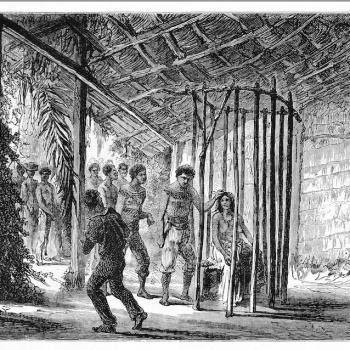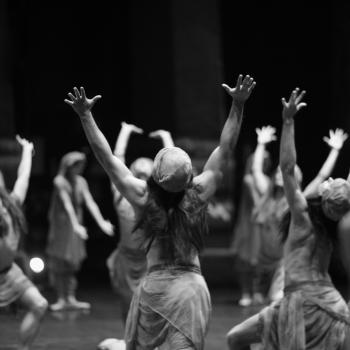Connor Wood
It’s dawn. You’re hiking over a silent mountain ridge, gravel crunching beneath your feet. You crest the top, and you’re struck dumb by the first rays of sunlight streaming over the valley below – rich, forested, cut through by rivers. Above you, the morning’s clouds blaze violet and orange with the sunrise. If you’re like most people, the emotion you’d be feeling right about now is awe: a sense of overwhelming wonder at natural splendor, power, or vastness. From Thomas Aquinas to Ralph Waldo Emerson, many writers over the centuries have linked awe with religious experience. Researchers from California have now joined that list, uncovering some fascinating additional connections besides.
Piercarlo Valdesolo and Jesse Graham are both experimental psychologists with publications in religion, ritual, and group processes. Valdesolo, a professor at Claremont McKenna College, has published some of the most interesting work on synchrony, or how rhythmic bodily motion affects people in groups. Graham has worked with moral psychologist Jonathan Haidt to explore how social conservatives differ from liberals – a topic that touches directly on religion and belief. Together, they set out to learn whether, as countless theologians and poets have suggested, awe actually increases people’s levels of religious faith.
Taking their cues from philosophers such as Søren Kierkegaard and William James, Valdesolo and Graham also wondered whether awe would induce an experience of uncertainty – after all, we usually feel awe when we’re confronted with something bigger, grander, or more aesthetically powerful than our logical minds can process. The emotion of awe, they conjectured, might actually be a type of affective tool for grappling with things that can’t be discursively understood.
Of course, numerous research studies have found that uncertainty wields a unique influence on religious belief. Namely, uncertain or random environments make people believe more strongly in God, spiritual purposes, and the afterlife – effects that researchers have explained by arguing that uncertainty and randomness produce epistemic and existential anxiety. We poor, befuddled humans find relief from this anxiety when we tell ourselves that someone is in charge – that someone has planned and designed things. In fact, we crave the presence of a designer so much that it doesn’t even have to be God; the illusion of a human designer is enough to make us feel more comfortable. What’s more, these effects are magnified in people with a high “need for cognitive closure,” psychology lingo for the need to settle ambiguities and clearly understand what is going on.
In a series of experiments, Valdesolo and Graham induced experiences of awe in research subjects by showing them videos of spectacular natural settings, such as waterfalls and mountain vistas. Control subjects were shown neutral videos, such as an old news interview. Several experiments tested whether awe-inspiring videos would encourage the subjects to believe more in God, while others tested whether subjects would perceive more human agency after experiencing awe. The experimenters measured belief in God and the supernatural with simple survey items with which subjects indicated their level of agreement, such as “The events that occur in this world unfold according to God’s or some other nonhuman entity’s plan.”
Human agency, meanwhile, was measured by asking subjects to look at a series of number strings, and then indicate whether they thought each string was produced by a random-number generator or by a live human being. The question was a trick, of course – all the number strings were produced by random number generators. In line with previous research, Valdesolo and Graham predicted that subjects who were motivated to intuit intentional design in their environment would be more likely to say the number strings were created by real people.
As the researchers expected, subjects in every relevant study who’d watched videos of spectacular natural scenes were more likely to say they believed in God or other spiritual claims. In the studies that included the random number lists, subjects were significantly more likely to agree that the strings of numbers were intentionally designed if they’d watched the awe-inspiring videos than if they watched the neutral ones.
These findings were paralleled in another study that substituted images of impressive but impossible situations for the videos of natural splendor. For instance, subjects were asked to view images of a waterfall running in a city street, since previous research had shown that such images also induced experiences of awe. This finding was corroborated when Valdesolo and Graham found that subjects who viewed the compelling-yet-impossible images were disproportionately likely to believe in supernatural claims.
In a key element of the design, several of the studies also included survey questions from a questionnaire commonly used to measure need for cognitive closure. For example, subjects indicated whether they agreed with items such as “I don’t like situations that are uncertain” or “I feel uncomfortable when someone’s meaning or intention is unclear to me.” Fascinatingly – and in line with the researchers’ predictions – volunteers who’d watched the awe-inspiring videos needed significantly more cognitive closure than those in the control condition.
Let’s just emphasize this point, because it’s weird and awesome: people who experienced awe were significantly more uncomfortable with ambiguity or uncertainty. In mediation analyses – a type of statistical technique that examines the means by which one variable influences another – the connection between awe and belief in God or human agency was found to be mediated through this increased intolerance for uncertainty. In other words, it wasn’t awe alone that made people more open to gods and human agents. It was that awe made people more intolerant of ambiguity, and this in turn led them to perceive more agents and believe in gods.
If this isn’t fascinating, I don’t know what is.
Valdesolo’s and Graham’s paper is the first experimental evidence that the emotion of awe can induce greater supernatural belief. Since many writers over the centuries have suggested that awe can make believers out of doubters, this finding isn’t especially surprising (although it’s useful to have concrete evidence to point to). But awe also boosted participants’ false perceptions of human agency – a finding that’s not necessarily intuitive at first glance. Finally, both these connections were mediated by intolerance for uncertainty: awe-inspiring images or videos induced a greater need for cognitive closure, which in turn led subjects to over-intuit agency and to accept supernatural claims. This effect, the researchers suggested, was similar to the well-documented finding that the experience of randomness encourages people to search harder for patterns and order. In an awe-inspiring, unknowable universe, it makes us feel more comfortable to think that someone is behind everything.
An interesting line of future research is suggested by the fact that, in previous studies, people who feel more awe in general in their lives tend to show less need for cognitive closure, not more. This means that while the transient experience of awe (apparently) decreases tolerance of uncertainty, experiencing a lot of awe over a long period of time has the opposite effect. This counter-correlation raises the question of whether longterm awe erodes religious belief. According to Valdesolo and Graham, religious faith is boosted by intolerance for uncertainty. But if awe over the long term decreases people’s need for cognitive closure, then seeing awe-inspiring sights every day for a year might “inoculate” people against religious belief. Of course, this seems unlikely, given that many great religious writers and theologians never seemed to tire of either natural splendor or God. But even unlikely hypotheses are worth testing.












